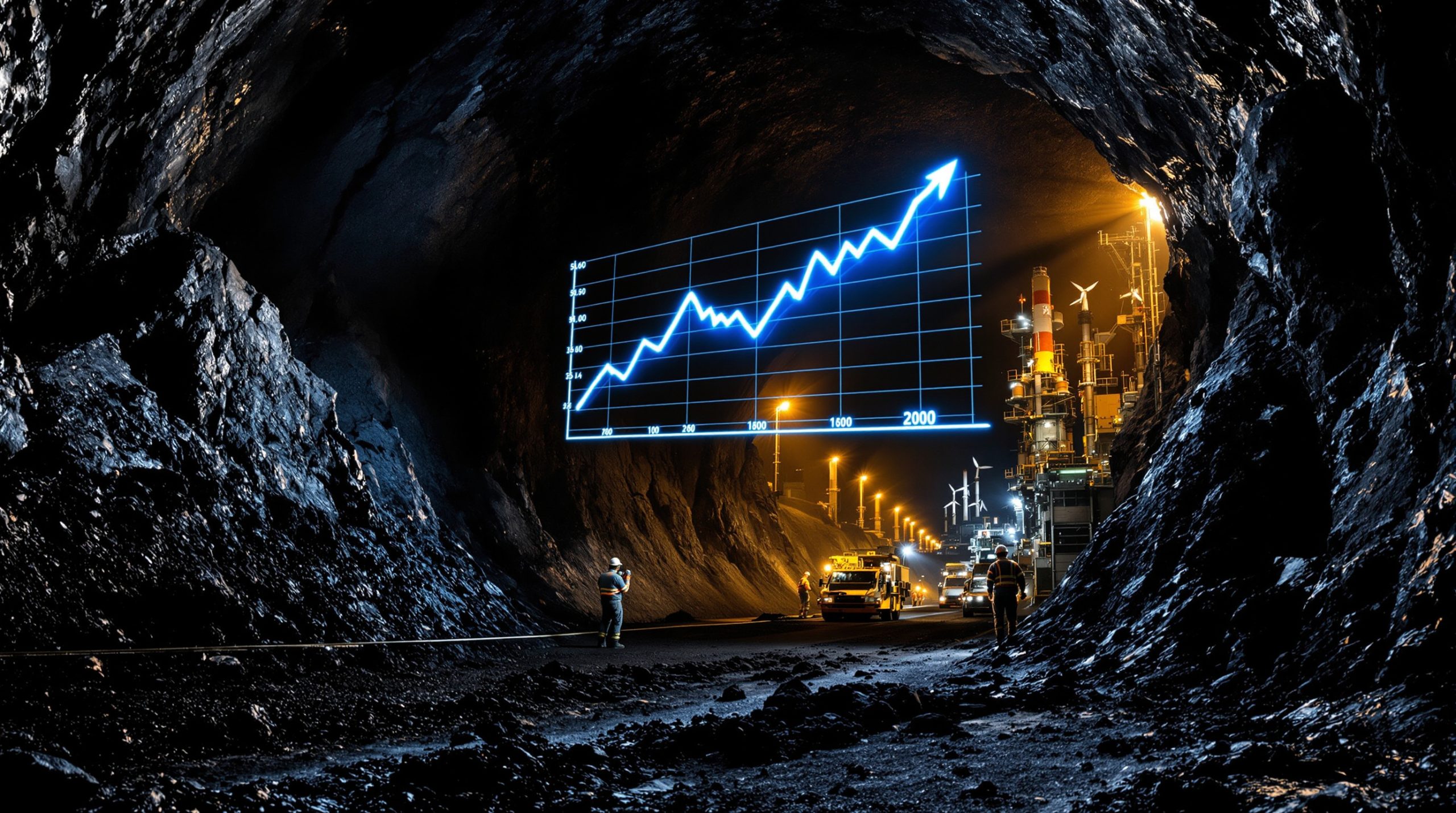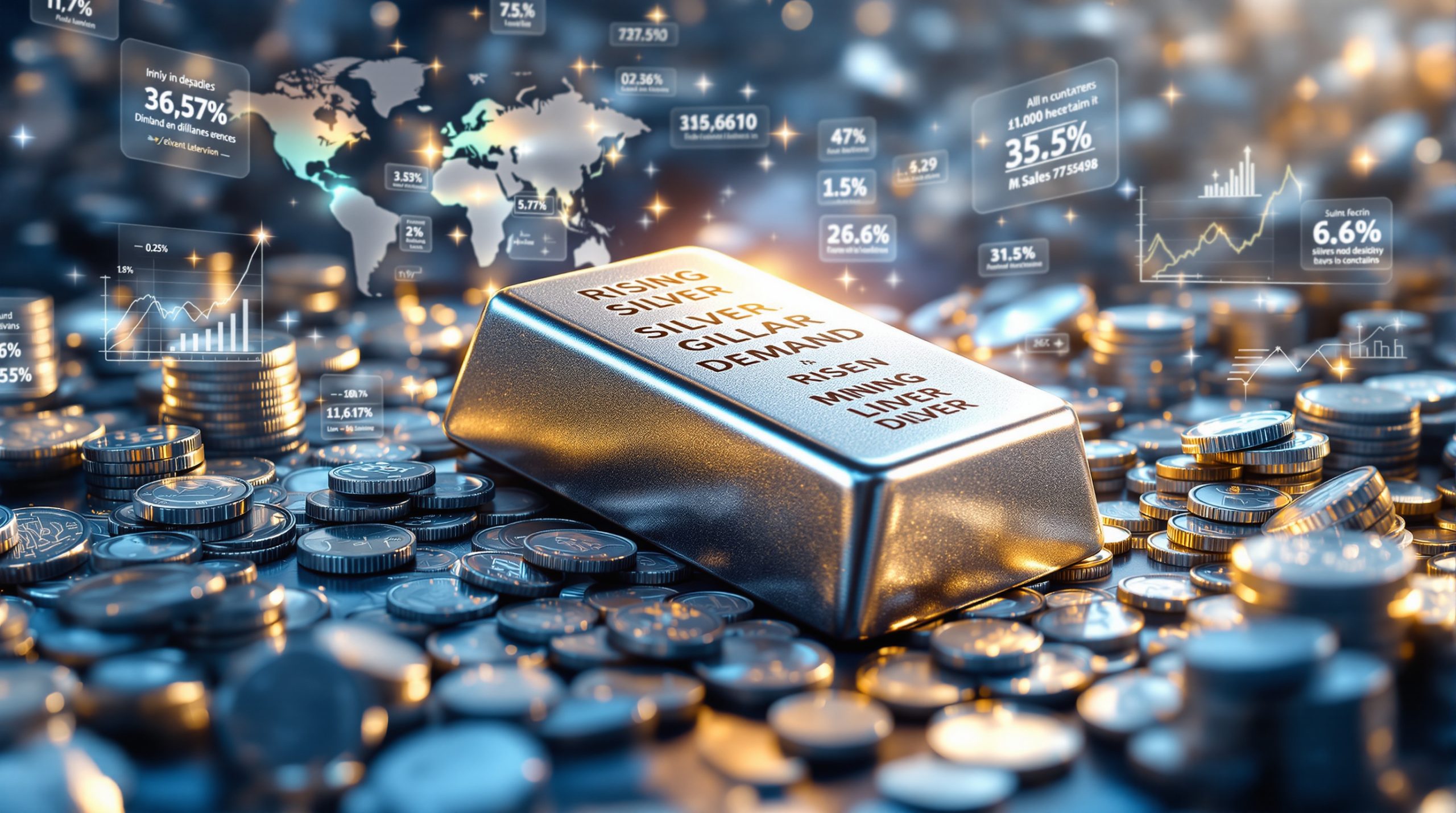What's Behind Silver's Recent Price Surge to $38?
Silver has surged to approximately $38 per ounce, marking a 14-year high in nominal terms and signaling a remarkable shift in market dynamics. This milestone represents a significant breakthrough after years of underperformance relative to gold. However, when adjusted for inflation, today's $38 price would equate to around $54 in 2011 dollars, indicating silver still has substantial room for growth before reaching true historical highs.
The precious metal has gained over 25% year-to-date, outpacing most other commodities and drawing attention from investors worldwide. According to Peter Spina, founder of GoldSeek.com and SilverSeek.com, "Silver's fundamentals favor rising prices: record industrial demand, structural deficits, and shifting investor sentiment are creating a perfect storm for higher valuations" (VRIC Media, 2025).
The Gold-to-Silver Ratio Tells a Story
The gold-silver ratio analysis has recently contracted from extreme levels near 100:1 to the high 80s, suggesting a rebalancing is underway. This ratio historically indicates:
- When extremely high (near 100:1): Silver is undervalued relative to gold
- When moderate (60-80:1): Markets are finding equilibrium
- When low (below 50:1): Silver may be overvalued relative to gold
Despite the recent price surge, the ratio remains historically elevated at above 80:1, indicating potential for further silver outperformance. Historically, major bull markets in precious metals have seen this ratio compress to 30:1 or lower.
Five-Year Structural Supply Deficit
A key fundamental driver behind silver's rise is the persistent structural supply deficit now in its fifth consecutive year. According to the Silver Institute's "World Silver Survey 2025," the market has experienced a cumulative shortfall of approximately 1.4 billion ounces since 2021, creating mounting pressure in physical markets.
Several factors contribute to this imbalance:
- Industrial demand reaching consecutive record highs: Solar panel manufacturing alone now consumes 20-30g of silver per panel, with the sector projected to use 20% of annual silver supply by 2030 (CRU Group, 2024)
- Mining production struggling to keep pace: No major silver mine starts since 2018 according to S&P Global
- Investment demand beginning to return: ETF inflows turning positive for the first time since 2021
- Above-ground inventories tightening: Visible stockpiles declining in both COMEX and LBMA warehouses
As JP Cortez, Executive Director of the Sound Money Defense League notes, "The fundamentals supporting silver have been building for years—it was only a matter of time before price discovery reflected these realities" (VRIC Media, 2025).
How Are Physical Silver Markets Responding?
The physical silver market is showing increasing signs of stress, with notable dislocations between paper and physical markets. These tensions often precede significant price movements as they highlight real supply constraints against paper trading volumes.
Signs of Physical Market Stress
Recent market indicators reveal mounting pressure in physical silver markets:
- New York silver premiums have jumped to $1 over London prices—the widest spread since the 2021 silver market squeeze event
- Rising silver lease rates have increased 0.5-1.5% according to LBMA data, indicating decreasing willingness to lend silver
- Significant inflows of physical silver into COMEX warehouses as traders seek delivery
- Movement of metal from London markets to U.S. markets to satisfy delivery demands
According to Peter Spina, "Physical tightness is exposing paper market flaws. Rising lease rates signal lenders are hoarding metal rather than making it available to the market—a classic sign of supply concerns" (VRIC Media, 2025).
The Retail vs. Wholesale Demand Divide
An interesting dynamic in the current silver rally is the divide between retail and wholesale demand:
- Retail demand in Western markets: Currently subdued with lower premiums than seen in previous rallies
- Wholesale and Eastern demand: Extremely robust, particularly in Asian markets
- India's role: Imports have doubled since 2023 according to GFMS data, making India an increasingly significant silver importer
This pattern suggests the rally has room to accelerate substantially if Western retail demand joins the already strong institutional and Eastern buying. As JP Cortez observes, "Asian demand dominates, but U.S. retail participation could ignite fireworks in the silver market 14-year high" (VRIC Media, 2025).
"What's unique about this rally is that Western retail investors—typically the last to enter and most aggressive buyers—haven't even shown up to the party yet. The groundwork for an explosive move is being laid." — Peter Spina (VRIC Media, 2025)
Who's Driving the Silver Market Higher?
The silver market is being propelled by a complex interplay of institutional, industrial, and monetary forces, with central banks playing a significant if indirect role in the precious metals complex.
Central Bank Influence on Precious Metals
While central banks primarily focus on gold purchases, their actions have significant spillover effects on silver:
- Central bank gold buying has reached record levels of approximately 1,000 tons annually (World Gold Council, 2025)
- Gold has overtaken the euro as the second-largest reserve asset globally after the U.S. dollar (IMF, 2024)
- Even U.S.-friendly nations like Poland and the Czech Republic are increasing gold reserves, with Poland now holding over 20% of its reserves in gold
- These strategic purchases reflect growing concerns about:
- Currency devaluation
- Geopolitical tensions
- Potential sanctions
- De-dollarization trends
JP Cortez explains: "Central banks aren't price-sensitive—they're hedging against sanctions and currency collapse. This isn't speculation; it's strategic positioning" (VRIC Media, 2025).
The Weaponization of Financial Systems
The 2022 sanctions against Russia following its invasion of Ukraine served as a wake-up call for many nations about the risks of dollar dependence. This has accelerated interest in gold and, by extension, silver as neutral monetary assets outside any single nation's control.
Peter Spina notes: "De-dollarization accelerates as nations like China stockpile off-books. The weaponization of the dollar has created a strategic imperative for countries to diversify into hard assets" (VRIC Media, 2025).
Industrial Demand Growth
Unlike gold, silver has substantial industrial applications that continue to expand:
- Solar panel production: Each panel requires 20-30g of silver, with the sector expected to consume 20% of annual supply by 2030
- Electronics manufacturing: Continues to grow with 5G implementation and smart device proliferation
- Medical applications: Antimicrobial properties driving increased usage in healthcare settings
- Electric vehicle components: Each EV uses approximately 50g of silver in various electrical systems
This dual nature as both a monetary and industrial metal is creating unprecedented demand pressure that mining supply struggles to meet.
What Technical Signals Are Silver Traders Watching?
Professional traders and technical analysts are closely monitoring several key patterns and price levels that could determine silver's next major move.
Key Price Levels and Chart Patterns
Technical analysts are watching several significant price levels and patterns:
- $40 per ounce: Major psychological resistance level that could trigger short-covering
- $48-50 range: Previous high area from 2011 that may trigger profit-taking
- 45-year cup and handle pattern: A massive long-term bullish formation potentially targeting triple-digit prices
JP Cortez observes: "$40 is psychological resistance; $48–$50 may trigger profit-taking from long-term holders who've waited over a decade to break even" (VRIC Media, 2025).
When analyzing historical price points in inflation-adjusted terms:
- The 1980 Hunt Brothers-induced spike would equate to nearly $200 per ounce today (BLS CPI calculator)
- The 2011 high of $49.80 would translate to approximately $65 in today's dollars
Quarterly Breakout Significance
The recent quarterly breakout on silver charts represents the first major technical development of this magnitude since 2011. This pattern is particularly significant given silver's long consolidation period of over a decade.
According to Peter Spina, "The quarterly chart breakout is extremely significant—these long-term technical signals tend to precede multi-year moves and rarely give false signals" (VRIC Media, 2025).
The 2021-2025 consolidation period has formed what technicians call a "base formation" similar to the pattern seen in the 1970s prior to silver's historic bull run (Bloomberg, 2025).
How Are Silver Mining Stocks Performing?
Despite silver's strong performance, mining stocks present a compelling value proposition for investors seeking leverage to rising metal prices.
Undervaluation Relative to Metal Prices
Mining equities remain significantly undervalued relative to the metal they produce:
- Many producers trading at P/E ratios of 5-7, well below market averages
- Production costs averaging around $15-25 per ounce according to the Silver Institute
- Substantial profit margins at current silver prices of $38/oz
- Balance sheets improving with increasing cash positions and debt reduction
Peter Spina highlights this disconnect: "Miners amplify metal gains by 3-5x historically. Many could double without the metal moving much higher from here—that's how undervalued this sector remains" (VRIC Media, 2025).
The Explorer-Developer Opportunity
The exploration sector presents particularly compelling opportunities:
- Many silver deposits trading at just 10-20 cents per ounce in the ground
- Limited new silver exploration over the past decade due to capital constraints
- Few pure silver plays as many companies shifted to gold during the bear market
- Potential for explosive moves as investors seek leverage to rising prices
"Explorers trade at 10–20¢/oz in-ground—this brutalized sector is now rebounding after years of neglect. The upside potential is enormous as capital begins flowing back." — Peter Spina (VRIC Media, 2025)
ETF Performance Metrics
Silver mining ETFs are beginning to outperform the underlying metal:
- SIL (Global X Silver Miners ETF) showing strong relative performance
- SILJ (Global X Silver Miners Junior ETF) has outperformed silver by 35% year-to-date (Global X, July 2025)
- GDX and GDXJ (gold mining ETFs) similarly outperforming their metal
A notable development in the sector was Tether's acquisition of a stake in royalty company Elemental Altus (Bloomberg, June 2025), signaling institutional interest in the mining stocks analysis space.
What Could Drive Silver to $50 and Beyond?
Several catalysts could propel silver significantly higher in the coming months, potentially driving prices to new nominal highs above the 2011 peak of $49.80.
Potential Catalysts for Higher Prices
Key factors that could trigger additional upside include:
- Western retail investor awakening: Currently largely absent from the market but historically a powerful force
- ETF buying acceleration: Just beginning to reverse previous outflows, with the first net positive flows since 2021
- Short covering: COMEX net short positions stand at approximately 150 million ounces (CFTC, July 2025)
- Monetary crisis scenarios: Potential for silver to benefit from currency instability
- Industrial demand growth: Continuing expansion in green energy and technology applications
JP Cortez describes the situation: "Western retail awakening could trigger explosive moves—like a coiled spring. When mainstream investors discover what's happening in silver, we could see demand overwhelm available supply" (VRIC Media, 2025).
Historical Price Perspectives
When adjusted for true inflation:
- The 1980 Hunt Brothers-induced spike of $50 would equate to nearly $200 per ounce today
- The 2011 high of $49.80 would translate to approximately $65 in today's dollars
This historical context suggests considerable upside potential remains, especially considering the 2011 rally saw silver gain over 400% in just 24 months, driven by a combination of ETF demand and industrial growth.
The monetary crisis link is particularly noteworthy—silver has historically performed exceptionally well during periods of fiat currency confidence collapses, as seen in the 1970s and 2008-2011 periods.
Is Sound Money Legislation Gaining Traction in the US?
While federal monetary policy remains unchanged, state-level initiatives to recognize gold and silver as money are gaining significant momentum across the United States.
State-Level Progress
The Sound Money Defense League reports substantial progress at the state level:
- 32 states (over 70%) introduced pro-gold and silver legislation in 2025
- 42 states now exempt precious metals from sales taxes
- Several jurisdictions have removed capital gains taxes on precious metals
- Wyoming established a $10 million physical gold reserve in 2024
JP Cortez, whose organization tracks these developments, notes: "We're seeing unprecedented momentum at the state level as legislators recognize the need for sound money alternatives in an era of fiscal uncertainty" (VRIC Media, 2025).
Challenges to Implementation
Despite progress, significant obstacles remain:
- Regulatory capture concerns with established financial institutions resisting change
- Surveillance and control mechanisms being built into some legislation
- Gresham's Law effects (bad money driving out good in circulation)
- Opposition from central banking authorities
The Florida Legislation Controversy
Recent Florida legislation highlights the complexities of reintroducing gold and silver as money:
- Marketed as making gold and silver usable as currency
- Created new regulatory structures and reporting requirements
- Brought gold and silver businesses under money services transmitter laws
JP Cortez offered a pointed critique: "Florida's bill is catastrophic—it imposes surveillance on bullion dealers under the guise of promoting sound money. This represents a serious misstep that could harm the industry" (VRIC Media, 2025).
This controversy demonstrates the challenge of crafting effective sound money legislation that genuinely empowers citizens rather than creating new regulatory burdens.
What's the Outlook for Silver Through 2025?
As silver trades at 14-year highs, investors are looking ahead to potential price targets and key factors that could influence the market through the remainder of 2025.
Near-Term Price Projections
Market analysts are watching several key price targets:
- $40: Immediate psychological resistance that could trigger significant short covering
- $45-50: Previous high range that may trigger profit-taking from long-term holders
- $50+: Potential target within the next 12 months if momentum continues
These targets align with technical patterns suggesting silver could be in the early stages of a major bull market cycle.
Fundamental Support Factors
Several fundamental factors support continued strength:
- Ongoing supply deficits projected at 215 million ounces for 2024 (Silver Institute)
- Limited new mine development with no major silver mine starts since 2018 (S&P Global, 2025)
- Growing industrial applications, particularly in green energy technologies
- Increasing monetary demand as inflation concerns persist
Peter Spina emphasizes the mining stock opportunity: "Mining stocks' catch-up potential is massive—many could double without metal moving much higher from current levels" (VRIC Media, 2025).
Risk Factors to Monitor
Potential headwinds include:
- Broad market corrections affecting all assets during economic downturns
- Economic slowdown reducing industrial demand for silver
- Central bank policy shifts that could affect precious metals sentiment
- Technical resistance at key price levels causing temporary pullbacks
The interplay between industrial and investment demand remains critical—unlike gold, silver's price can be significantly affected by economic slowdowns that reduce manufacturing activity.
FAQ: Silver Market Questions
How does inflation affect silver prices?
Silver typically performs well during inflationary periods as investors seek tangible assets to preserve purchasing power. Historical data shows silver has averaged gains of 15-20% annually during periods of above-average inflation. However, silver's industrial component means it can be negatively affected if inflation leads to economic slowdown that reduces manufacturing output.
What's the relationship between gold and silver prices?
Gold typically leads major precious metals moves, with silver following and eventually outperforming during bull markets. The gold-to-silver ratio tends to contract during strong bull markets and expand during corrections or bear markets. During the 1970s bull market, this ratio compressed to below 20:1, suggesting significant potential upside for silver if historical patterns repeat.
How do silver ETFs impact the physical market?
Exchange traded commodities create additional demand when investors are bullish, requiring the funds to purchase physical metal. During bearish periods, ETF outflows can add supply to the market. According to Bloomberg data, ETF flows have recently turned positive for the first time since 2021, potentially sign
Ready to Catch the Next ASX Mining Discovery?
Discover how major mineral discoveries can lead to exceptional market returns by exploring Discovery Alert's dedicated discoveries page, where our proprietary Discovery IQ model provides real-time alerts on significant ASX mineral discoveries, transforming complex data into actionable insights for immediate investment opportunities.




